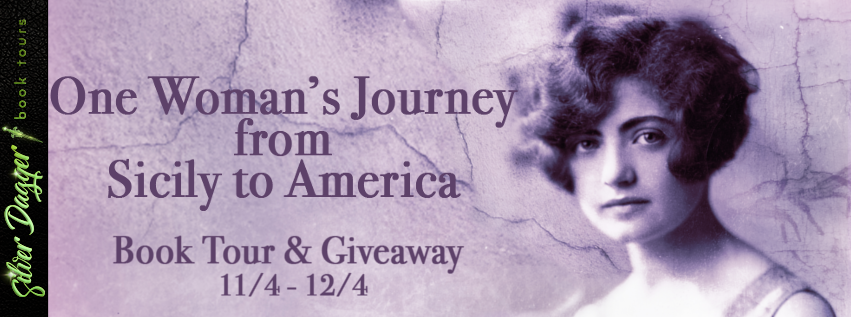Spotlight: One Woman's Journey from Sicily to America by Carmela Cattuti
/Between the Cracks
One Woman's Journey From Sicily to America Book 1
Genre: Historical Women's Fiction
Join Angela Lanza as she experiences the tumultuous world of early 20th century Sicily and New York. Orphaned by the earthquake and powerful eruption of Mt. Etna in 1908, Angela is raised in the strict confines of an Italian convent. Through various twists of fate, she is married to a young Italian man whom she barely knows, then together with her spouse, immigrates to the U.S. This novel is an invitation to accompany the young Angela as she confronts the ephemeral nature of life on this planet and navigates the wide cultural gaps between pre-World War II Italy and the booming prosperity of dynamic young America.
Author, artist, and teacher Carmela Cattuti created Between the Cracks as an homage to her great-aunt, who survived the earthquake and eruption of Mt. Etna and bravely left Sicily to start a new life in America.
Excerpt
Prologue
Across from Italy’s mainland sat the city of Messina like an indomitable fortress. Proud of its solid presence, Messina was the travelers’ first encounter with the island of Sicily. The earthy colors of the buildings and landscape signaled to the visitor or returning Sicilian that Messina and its people belonged to the island, not to any outside political force or cultural tradition. The clang of the donkey-drawn carts and the voices calling out to customers to buy wares in the market added to the music of the city’s sounds. Visitors marveled out loud at the cathedrals and ancient artwork throughout the city, but the locals walked and spoke softly, especially near the narrow slits between the buildings.
Visitors delighted in the snake-like movement of the streets. Most led directly to a famous church or street market but then would slowly veer off in a different direction. They seemed to be designed to intentionally confuse. The city offered no help in arriving at a specific destination.
Ancient buildings were so close together that air barely squeezed through. Residents believed that between the buildings old mysteries sat, holding the true essence of Messina. Townspeople walking close to the openings felt a whisper—not a sound you could hear with your physical ears but heard in your mind. The whisper seemed to convey a yearning that had been imprisoned for hundreds of years. When this happened, people scurried past, heads down.
Hopelessness was the disease that plagued the citizens of Messina during the early twentieth century. The city was so congested with ancient energy it felt like it could explode—and small eruptions did occur. Whenever some of the dark energy needed release, outbursts took place between the locals who were often surly with one another. Their interactions were always based on scarcity, and not just in terms of money. If a resident didn’t show enough respect to a compatriot, there would be a confrontation. If someone had more stylish clothes than another, there would be jealousy over their lack of quality clothes. If a citizen had more leisure time than the next person, there would be gossip about how the person with more time for pleasure was lazy and didn’t deserve the extra time. Daydreaming was frowned upon. What was the point of daydreaming when it was just fantasy and would never come true?
The city’s poor were especially vulnerable to the local mafia and thieves. Many of the men met an early death at the hands of murderers, accidents from factory jobs or shoveling coal, or disease. Women were left to raise children who would most likely not move above their family’s social status. The lack of light between the buildings prevented transcendence or change. This cycle had repeated itself for hundreds of years.
The dark energy of Messina was relentless in its hunger for the human spirit. Feeding off people’s dreams, it left them with doubt, fear, and misery. This shadowy energy prided itself on soul theft. Once the soul was stolen, an overwhelming amount of energy was required to retrieve it—and few in Sicily were familiar with the practice of soul retrieval.
The neighborhoods were filled with children running, playing, singing, and giggling. Youth were not affected by the dark energy. They nourished each other with joy and playfulness; qualities that the malevolent force could not penetrate. The children breathed deeply and dreamed blissful scenarios of the future, but when they returned to their homes, a grim reality met the physical eyes of many: parents yelling, often with a blow or two to a mother’s face or stomach from a drunken father. Imperceptibly, like a slow death from a chronic debilitating disease, the children played less and gave up their bliss and dreams to the heavy energy between the buildings.
The cycle of poverty and abuse branched out through time like a spider unconsciously spinning its web. No police force protected the women or the poor, so the residents lived in fear of everything. Unconsciously, they feared the small spaces between the buildings. At times, a glimmer of light seeped into the locals’ fear. This usually took place in their conversation around sunset, when many would gather in the town piazza.
There was talk of freedom and protection in America. The townspeople heard it was a country where anyone could become rich—but more than that, one could become happy. America equaled happiness. They didn’t know what happiness felt like, but they were sure they could find it if only they could go to America. However, few had true hope of leaving Messina. The spark of light ignited by these conversations flickered but was extinguished at the last spoken word.
It wasn’t that the townspeople couldn’t find a way to get to the New World; there just wasn’t enough determination or will. When the energy between the buildings took their will, the residents were left with despair. While the Black Plague of the Middle Ages had been cured by an awareness of sanitation techniques, the town’s hopelessness could only be cured by cleansing Messina of the dark, heavy energy. This would require a belief that they could reclaim their stolen individuality, comprised of their dreams and hopes. In the end, it was easier to cure the Plague.
The shadowy energy became so thick at times that it took on form. It was a master shape-shifter that became stronger as it gathered human dreams. From the corners of their eyes, the residents would perceive a shape leaning against a building—but when they looked directly at the form, it would vanish. This energy frightened the residents into thinking that they had to stay in the city to remain safe.
The dark energy took whatever it could from the city’s residents. But for 13-year-old Angela Lanza, neither her dreams nor her distinct presence could be stolen. Her awareness had never allowed it. Different from her contemporaries, as she entered adolescence, she was increasingly able to communicate with the unseen. She hadn’t been afraid of the lurking, mysterious force between the buildings, as visions while she slept had instructed her how to oppose this force.
One night, during a dream, two beings appeared to her. Both had shoulder-length, wavy, light hair and faces glowing with a radiance that compelled her to look away at first. Angela realized she was dreaming and looked back at the faces of the beings, with light streaming toward her. These creatures explained that they were infusing her with light for protection against the dark power of the city. If she paid attention to their guidance, she would live to manifest her dreams and aspirations and use her will to do so.
When she awoke, she felt special. Whenever she was sad, alone, or ridiculed, Angela would think of the two friends from her dream and know everything would be all right. She maintained the integrity of her internal space and knew she could not be violated by the shadowy energy. She stayed away from certain buildings without really knowing why. At times, her body seemed to be guided by an unseen, gentle sensation or a distant voice inside her head. She sensed that her time in Messina would be short—that she wasn’t supposed to stay here.
Angela no longer attended school, which was typical of girls of her age. The oldest of three children, it was her responsibility to help her mother. One day, she came home to learn her father who had been a silk trader was killed on the silk trade route and would not return. A few weeks later, a man moved into their house. Her mother explained that he would help with the rent. After a few months, Angela noticed her mother’s belly protruding beneath her homemade, faded smock. Angela pretended she did not notice. She thought of her dream friends and felt less alone.
In December of 1908, the earth made a decision that would change the lives of Messina’s inhabitants forever. The amount of pressure caused by the malevolent energy between the city’s buildings seeped under the earth and into the surrounding area. It nestled itself under Mt. Etna, an active volcano.
After Mt. Etna erupted, causing an earthquake, the city moaned. Screams from the undead, buried under debris, echoed off the skeletons of structural remains. It was as if the earth released a scream that resounded through time, releasing a millennium of abuse and maltreatment.
The morning the earth exploded; Angela was awoken from her sleep. She and her younger brother, Antonio, jumped out of their second-floor window and ran to the edge of the city, where she blacked out and started to drift. She floated above the earth, peering down onto the city. She saw people running, buildings collapsing, and gaping holes in the earth.
Copyright © 2013 by Carmela Cattuti
All rights reserved.
Published by Three Towers Press
An imprint of HenschelHAUS Publishing, Inc.
The Ascent
One Woman's Journey From Sicily to America Book 2
The sequel to Carmela Cattuti's first novel, Between the Cracks,, this story invites the reader to accompany Angela Lanza as she builds her life in America during the first half of the 20th century. A Sicilian immigrant, she manages to assimilate into the social life of a small town outside of New York City. Through the horrors of war, domestic tragedy, and raising her sister-in-law's children, hers is a successful immigrant experience. Angela seeks to transcend organized religion and develop her spirituality. She influenced three generations of Americans through her artistic sensibility and a sharpened intuition. The book parallels America's growth with Angela's growing sense of who she is in the world.
Buy on Amazon
About the Author
Carmela Cattuti started her writing career as a journalist for the Somerville News in Boston, MA. After she finished her graduate work in English Literature from Boston College she began to write creatively and taught a journal writing course at the Cambridge Center for Adult Education As fate would have it, she felt compelled to write her great aunt's story. “Between the Cracks” has gone through several incarnations and will now become a trilogy. The second book is "The Ascent."
The third book will be released in early 2021.
Website * Facebook * Twitter * Instagram * Amazon * Goodreads



















































